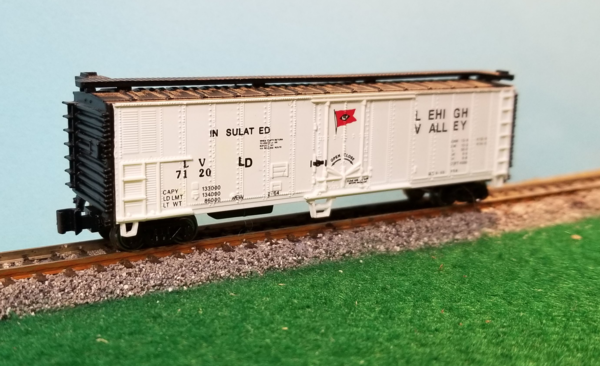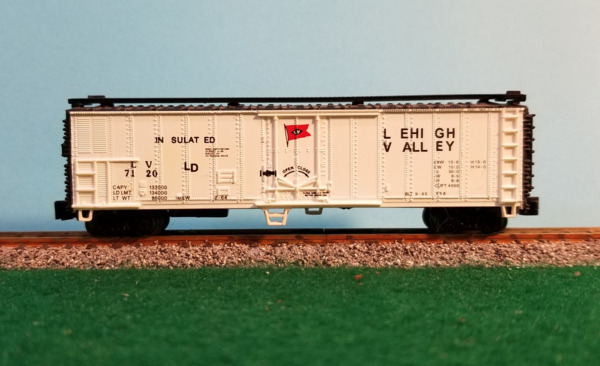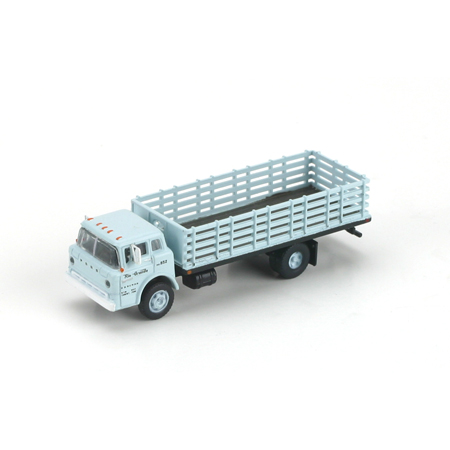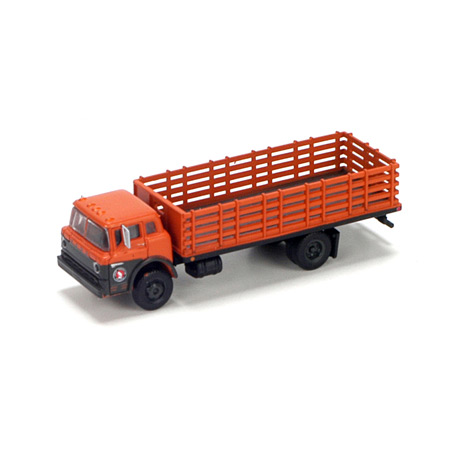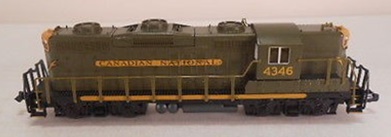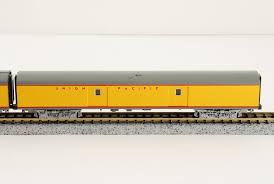Prototype History: The purpose of a mechanical reefer is to keep perishable items cold. Early reefers were of all wood construction and used ice for cooling. By the 1940s, new reefers were being built entirely of steel. Insulating techniques improved to the point where economical refrigeration could be accomplished using steel side plates in place of wood sheathing. Fifty foot mechanical reefers date back to at least the late 50s / early 60s.
The mechanical reefers could keep a more regular temperature, and often times colder than what the ice bunker cars were capable of. Initially mechanical reefers were used primarily in frozen food service. This would soon change as mechanical refrigeration began to replace ice-based systems. Soon after, mechanical refrigeration units replaced the “armies” of personnel required to re-ice the cars.
The first record of a 50' mechanical refrigerator car with a 6' plug door appears in the October 1954 Official Railway Equipment as with reporting marks FGEX 1000 - 1100. The January 1958 Official Railway Equipment Register lists over 600 of these cars. They appear with road numbers between 1000 and 1600. The build dates will fall between these two dates.
They were first acquired for orange juice service out of Florida. Similar cars were owned by WFEX and BREX. All were used in pool service with one another, depending upon the season. You can find a remaining prototype preserved in the NC Transportation Museum in Spencer, NC.
The mechanical reefers could keep a more regular temperature, and often times colder than what the ice bunker cars were capable of. Initially mechanical reefers were used primarily in frozen food service. This would soon change as mechanical refrigeration began to replace ice-based systems. Soon after, mechanical refrigeration units replaced the “armies” of personnel required to re-ice the cars.
The first record of a 50' mechanical refrigerator car with a 6' plug door appears in the October 1954 Official Railway Equipment as with reporting marks FGEX 1000 - 1100. The January 1958 Official Railway Equipment Register lists over 600 of these cars. They appear with road numbers between 1000 and 1600. The build dates will fall between these two dates.
They were first acquired for orange juice service out of Florida. Similar cars were owned by WFEX and BREX. All were used in pool service with one another, depending upon the season. You can find a remaining prototype preserved in the NC Transportation Museum in Spencer, NC.
Road Name History:  The Lehigh Valley Railroad (reporting mark LV) was one of a number of railroads built in the northeastern United States primarily to haul anthracite coal. It was authorized April 21, 1846 in the U.S. state of Pennsylvania and incorporated/established on September 20, 1847 as the Delaware, Lehigh, Schuylkill and Susquehanna Railroad Company. On January 7, 1853, the name was changed to Lehigh Valley Railroad. It was sometimes known as the Route of the Black Diamond, named after the anthracite it transported. At the time, anthracite was transported by boat down the Lehigh River; the railroad was meant to be faster transportation. The railroad ended operations in 1976 and merged into Conrail that same year.
The Lehigh Valley Railroad (reporting mark LV) was one of a number of railroads built in the northeastern United States primarily to haul anthracite coal. It was authorized April 21, 1846 in the U.S. state of Pennsylvania and incorporated/established on September 20, 1847 as the Delaware, Lehigh, Schuylkill and Susquehanna Railroad Company. On January 7, 1853, the name was changed to Lehigh Valley Railroad. It was sometimes known as the Route of the Black Diamond, named after the anthracite it transported. At the time, anthracite was transported by boat down the Lehigh River; the railroad was meant to be faster transportation. The railroad ended operations in 1976 and merged into Conrail that same year.
During its existence, the Lehigh Valley Railroad used a rail line that later became known as the Lehigh Line in order for it to operate. The Lehigh Line was the railroad's first rail line constructed which was built in 1855 between Easton, Pennsylvania and Allentown, Pennsylvania and it served as the main line for the Lehigh Valley Railroad. Serving as the main line for the Lehigh Valley Railroad, the rail line expanded past Allentown to Buffalo, New York and past Easton to New York City, bringing the Lehigh Valley Railroad to these metro areas. During the early years, the line served as the body of the Lehigh Valley Railroad until the railroad either built more rail lines or railroads, acquired more rail lines or railroads, and merged other railroads into their system. The line was known as the Lehigh Valley Mainline during the majority of its time under the ownership of the Lehigh Valley Railroad, starting in the 1930s. The "Lehigh Valley" was absorbed along with several northeastern rail lines into Conrail; the main line became known as the Lehigh Line during the Conrail ownership. Conrail shortened the track miles by abandoning most of its route to Buffalo and some of the line entering New York City area. The Lehigh Line is now owned by the Norfolk Southern Railway.
As of 31 Dec 1925, 1363.7 miles of road, 3533.3 miles of track; as of 31 Dec 1970, 927 miles of road and 1963 miles of track.
From Wikipedia

During its existence, the Lehigh Valley Railroad used a rail line that later became known as the Lehigh Line in order for it to operate. The Lehigh Line was the railroad's first rail line constructed which was built in 1855 between Easton, Pennsylvania and Allentown, Pennsylvania and it served as the main line for the Lehigh Valley Railroad. Serving as the main line for the Lehigh Valley Railroad, the rail line expanded past Allentown to Buffalo, New York and past Easton to New York City, bringing the Lehigh Valley Railroad to these metro areas. During the early years, the line served as the body of the Lehigh Valley Railroad until the railroad either built more rail lines or railroads, acquired more rail lines or railroads, and merged other railroads into their system. The line was known as the Lehigh Valley Mainline during the majority of its time under the ownership of the Lehigh Valley Railroad, starting in the 1930s. The "Lehigh Valley" was absorbed along with several northeastern rail lines into Conrail; the main line became known as the Lehigh Line during the Conrail ownership. Conrail shortened the track miles by abandoning most of its route to Buffalo and some of the line entering New York City area. The Lehigh Line is now owned by the Norfolk Southern Railway.
As of 31 Dec 1925, 1363.7 miles of road, 3533.3 miles of track; as of 31 Dec 1970, 927 miles of road and 1963 miles of track.
From Wikipedia
Brand/Importer Information: Bachmann Industries (Bachmann Brothers, Inc.) is a Bermuda registered Chinese owned company, globally headquartered in Hong Kong; specializing in model railroading.
Founded in Philadelphia, Pennsylvania, the home of its North American headquarters, Bachmann is today part of the Kader group, who model products are made at a Chinese Government joint-venture plant in Dongguan, China. Bachmann's brand is the largest seller, in terms of volume, of model trains in the world. Bachmann primarily specializes in entry level train sets, and premium offerings in many scales. The Spectrum line is the high quality, model railroad product line, offered in N, HO, Large Scale, On30, and Williams O gauge all aimed for the hobbyist market. Bachmann is the producer of the famous railroad village product line known as "Plasticville." The turnover for Bachmann model trains for the year ended 31 December 2006 was approximately $46.87 million, a slight increase of 3.36% as compared to 2005.
Founded in Philadelphia, Pennsylvania, the home of its North American headquarters, Bachmann is today part of the Kader group, who model products are made at a Chinese Government joint-venture plant in Dongguan, China. Bachmann's brand is the largest seller, in terms of volume, of model trains in the world. Bachmann primarily specializes in entry level train sets, and premium offerings in many scales. The Spectrum line is the high quality, model railroad product line, offered in N, HO, Large Scale, On30, and Williams O gauge all aimed for the hobbyist market. Bachmann is the producer of the famous railroad village product line known as "Plasticville." The turnover for Bachmann model trains for the year ended 31 December 2006 was approximately $46.87 million, a slight increase of 3.36% as compared to 2005.
Item created by: gentgeen on 2021-10-30 14:50:48. Last edited by gentgeen on 2021-11-01 08:20:23
If you see errors or missing data in this entry, please feel free to log in and edit it. Anyone with a Gmail account can log in instantly.
If you see errors or missing data in this entry, please feel free to log in and edit it. Anyone with a Gmail account can log in instantly.


